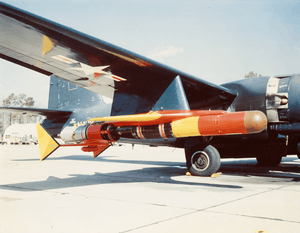AUM-N-2 Petrel
| AUM-N-2 Petrel | |
|---|---|
|
A Petrel carried by a P2V Neptune aircraft. | |
| Type | Guided missile |
| Place of origin | United States |
| Service history | |
| Used by | United States Navy |
| Production history | |
| Manufacturer | Ranger/Fairchild Engines |
| Specifications | |
| Weight | 3,800 lb (1,700 kg) |
| Length | 24 ft (7.32 m) |
| Diameter | 24 in (61 cm) |
| Warhead | One Mark 21 Mod 2 torpedo. |
|
| |
| Engine | Fairchild J44 turbojet, thrust 1,000 lb (450 kg) |
| Wingspan | 13 ft 2 in (401 cm) |
| Propellant | Jet fuel (Kerosene) |
| Speed | 375 mph (604 km/h) |
The AUM-N-2 Petrel was an air-to -surface missile produced by the United States of America. Later variants were converted into AQM-41A target drones.
Design and development
The origins of the Petrel date back to the 1950s, when the U.S. Navy Bureau of Ordnance (BuOrd) began the Kingfisher program, intending to develop a series of standoff torpedo weapons. The Kingfisher C, later known as the AUM-2 and then as AUM-N-2 (AUM representing Air-to-Underwater Missile), was designed as an air-launched jet-powered missile which carried a torpedo warhead. Various different design options were considered for this missile; the final choice was a Mark 21 homing torpedo, with a Fairchild J44 turbojet engine, wooden fins and wings, and a nose housing guidance equipment. On launch the missile dropped to 60 meters (200 feet) above the water and cruised at Mach 0.5 towards the target, using semi-active radar homing. At a range of just under 1,500 meters (4,600 feet) the engine shut down and all wings and fins were jettisoned. The torpedo dropped on a free trajectory into the water and began to home in on the target. The weapon was suitable for use against surface targets only—primarily ships and surfaced submarines. The AUM-2 was usually carried by the Lockheed P-2 Neptune.
Tests of the AUM-2 began in 1951. Development was transferred to Fairchild in 1954, with the project becoming operational in 1956.
The Petrel was never considered a very high priority by the U.S. Navy, which was far more concerned about the threat from submarines than surface ships. New submarine designs powered by nuclear reactors were beginning to appear in the mid-1950s, vessels which could remain submerged indefinitely. As a result the prospects of catching an enemy submarine on the surface were receding, and more emphasis was being placed on underwater engagements. The use of semi-active guidance also required the launching aircraft to continue closing the target throughout the missile's flight, exposing it to a far greater danger from enemy defenses. The AUM-N-2 was initially assigned only to reserve units. In 1959 the missiles were withdrawn from reserve service and converted to serve as air-launched target drones.
In 1962, the remaining Petrel drones were re-designated as the Fairchild AQM-41A. They were finally disposed of shortly afterwards.
